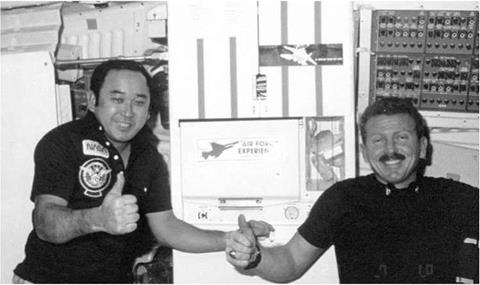STS 51-C
|
Int. Designation |
1985-010A |
|
Launched |
24 January 1985 |
|
Launch Site |
Pad 39A, Kennedy Space Center, Florida |
|
Landed |
27 January 1985 |
|
Landing Site |
Runway 15 North, Kennedy Space Center, Florida |
|
Launch Vehicle |
OV-103 Discovery/ET-14/SRB BI-015/SSME #1 2109; |
|
#2 2018; #3 2012 |
|
|
Duration |
3 days 1 hr 23 min 23 sec |
|
Callsign |
Discovery |
|
Objective |
First classified dedicated DoD shuttle mission |
Flight Crew
MATTINGLY, Thomas Kenneth, 48, USN, commander, 3rd mission Previous missions: Apollo 16 (1972); STS-4 (1982)
SHRIVER, Loren James, 40 USAF, pilot ONIZUKA, Ellison Shoji, 38, USAF, mission specialist 1 BUCHLI, James Frederick, 39, USMC, mission specialist 2 PAYTON, Gary Eugene, 36, USAF, payload specialist
Flight Log
This mission was originally to have been designated STS-10 and to have flown in January 1984. When it finally got to the launch pad as STS 51-C (originally designated STS-20), it was assigned to orbiter Discovery, rather than Challenger, which was suffering a rather disturbing tile problem. The assignment of Discovery to the mission caused a disruption to the 1985 Shuttle schedules. Although a classified military mission, press leaks resulted in most people knowing full well what the STS 51-C crew would be doing: deploying a geostationary electronic monitoring satellite on an IUS upper stage. It was also unique in that it carried the first military specialist passenger, Gary Payton, from a cadre of US Air Force Manned Space Flight Engineers, most of whom it was anticipated at the time would fly on later military Shuttle missions.
The launch of STS 51-C was delayed by one day by the coldest weather in memory at the KSC and was quite spectacular a day later at 14: 50 hrs. The countdown had not been announced until T — 9 minutes under new rules for military launches, although observers could tell it was in progress a lot earlier by seeing wisps of liquid oxygen coming off the ET. Discovery entered a 28.4° inclination orbit with a maximum altitude of 341 km (212 miles). Trouble with the IUS on the STS-6 mission had been the main reason for this mission’s delay, and after the Acquacade ELINT (electronic
|
USAF astronauts Onizuka (left) and Shriver give the thumbs up during the classified STS 51-C mission |
signals intelligence satellite) had been deployed, the IUS misbehaved again, its first stage thrust shortfall being made up by thruster firings.
Discovery also carried a blood flow experiment but little else was officially reported about the mission, which ended after the shortest five-crew flight of just T + 3 days 1 hour 23 minutes 13 seconds on runway 15 at the KSC.
Milestones
103rd manned space flight
46th US manned space flight
15th Shuttle mission
3rd flight of Discovery
1st US classified manned military mission
1st flight of a Military Spaceflight Engineer (MSE – Payton)











